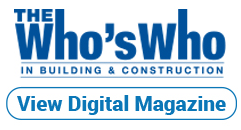When What’s Under is Top Priority
Continuous focus on industry advancements spurs evolution of Flooring Solutions

Flooring Solutions Owner and President Kevin Haughey.

It’s equipment maintenance day at Flooring Solutions! Crew members helping out include (left to right): Dan Beagan, Bruce Stravato, Manny Pina, Dan DelGado and Edder Patrick.
Just as buildings require strong foundations, the same goes for floors. Below-the-surface materials and workmanship determine the precision and effectiveness of floor-surface leveling and floor-to-subsurface adhesion. Even so, the floor-preparation business has only a few specialty contractors.
“In fact, there are only a handful of us throughout New England,” says Flooring Solutions Owner and President Kevin Haughey, who, in 2002, founded the Warwick, Rhode Island, firm as “the state’s first and only such contractor.”
While the shortage of floor-preparation contractors hasn’t changed, materials and systems have, creating increased opportunities for Haughey and his team of 12 to 20 employees, many of whom have been with the company for 10 or more years. One such employee, Project Manager Doug Edwards, cites the company’s top-of-the-field compensation, continuous training via manufacturer-distributor seminars and field training, and a quality-focused company culture as “reasons why our associates remain here.”
As for the increased opportunities, Haughey, a 39-year industry veteran who worked for a flooring manufacturer and wholesaler, and owned two flooring stores, provides a look at the company’s evolution.
Setting the Bar
Just two years after the company launched with seven employees, Flooring Solutions became a LevelMaster Elite (LME) installer of self-leveling cement-based underlayments for smoothing and flattening surfaces made by ARDEX Americas of Aliquippa, Pennsylvania. Haughey notes that at the time, “Flooring Solutions was just one of 12 companies nationwide to earn this distinction; today there are 38. To become an LME installer requires continuous new-product training and regular performance and quality checks by ARDEX personnel. This assures customers the best installation and extended warranties available."
From there, Flooring Solutions’ business expanded, helped in part by environmentalists.
Haughey explains, “The flooring industry, as part of a green initiative, reduced the volatile organic compound content in the flooring adhesives, resulting in concrete bonding problems and a need for a concrete moisture-mitigation system” that became step two of a three-step process. The process: 1) shotblast the concrete; 2) apply a two-part epoxy-based mitigation system that penetrates the concrete, reducing moisture seepage, a common cause of bonding issues; and 3) prime and pour a leveling layer of underlayment that serves as a blotter layer, giving the moisture in the adhesives somewhere to go while providing a smooth, porous surface for effective bonding.
“It’s the moisture-mitigation systems that really got us going in 2004, and this remains a big part of our business today,” says Haughey, who figures that the moisture mitigation and underlayment represent about 85 percent of the company’s business, with the remaining being resinous (epoxy) floors. “It was our moisture-mitigation work,” he says, “with the epoxy material that introduced us to resinous flooring.”
50/50 String of Successes
During the past five years, Haughey says the company’s business mix has evolved from 90 percent commercial and 10 percent multifamily residential to a 50/50 mix.
Successful case studies are many. An early project in 2008 became an important part of the multiyear conversion of the 360,000-square-foot Assembly Square Mall, once an abandoned Ford assembly plant, to what is now a mixed-use complex in Somerville, Massachusetts. With its range of floor pitches, the facility posed floor-leveling challenges for the Flooring Solutions crew.
Renovations such as the auto-plant-turned-mall project are just 25 percent of Flooring Solutions’ business, while 75 percent of the company’s revenue comes from new construction projects. Among them are:
Rhode Island School of Design North Hall dormitory, Providence, Rhode Island. Completed in August 2019, this $25 million, six-story, 40,800-square-foot project is the school’s first new residence hall in 34 years and the first project constructed with cross-laminated timber (CLT). With exposed wood in the ceiling and wood used as the structural floor, the CLT provides a distinctive look while speeding installation because of its light weight—it is about five times lighter than concrete, though its strength-to-weight ratio is comparable. “Installation time,” Haughey says, “was cut by 50 percent; from six to three days.”
That’s not to say the project wasn’t without challenges. “Since it’s a dormitory, our job was to provide a system that would achieve high sound ratings,” Haughey says. “The soluton: a three-component system comprised of a sound-reduction board, a sound mat and 2 inches of gypsum underlayment. This system, which we will also install at Brown University this fall, achieved 50 Sound Transmission Class (STC) and 50 Impact Insulation Class (IIC) ratings.” The STC rating means that airborne noise, such as raised voices, are blocked from traveling to adjacent rooms while the IIC rating means that impact sounds, such as footsteps, are effectively absorbed.
Washington Village, Norwalk, Connecticut. Funded in part by the U.S. Department of Housing and Urban Development’s $30 million Choice Neighborhoods grant, this three-phase, 260,000-square-foot project provides 136 public housing units as well as 137 units for workforce housing and market-rate housing. The project called for the installation of a gypsum underlayment system with a sound mat. Seasonal challenges came with the project. “With phase 2 work occurring last winter,” Haughey says, “we had to bring in portable heaters to provide heat around the pump area to prevent icing of the pump and freezing of the pumped sand that was mixed with the bagged material as part of the pumping process.”
Montgomery Mill Apartments, Windsor Locks, Connecticut. This 2019 project involved the conversion of the J.R. Montgomery Company fabric mill to housing units, with Flooring Solutions providing concrete mitigation and gypsum underlayment throughout the housing and lobby areas. “The challenge with this project,” Haughey says, “involved multiple types of existing surfaces that we prepared for finished flooring.”
Taconic High School, Pittsfield, Massachusetts. Finished in fall 2018, this $120 million, 246,000-square-foot facility called for moisture mitigation and installation of resinous flooring in the bathrooms, locker rooms, training kitchen and cafeteria.
Rhode Island Veterans Home, Bristol, Rhode Island. Finished in late 2017, this $121 million, 208-bed, 260,00-square-foot facility saw a Flooring Solutions crew provide shotblasting of concrete, application of a moisture-mitigation system and installation of a cement/polymer-based underlayment.
Looking Ahead
“What sets us apart is our continuous focus on floor preparation,” Haughey says. “That won’t change as we continue to look for new growth opportunities and as underlayment materials advance, as seen in the growing acceptance of gypsum underlayments as an alternative to traditional lightweight cellular concrete.”
Meanwhile, Haughey says Flooring Solutions will continue to provide its employees with training and equipment necessary for doing quality installations.
“We take pride in being a hands-on business with 99 percent of our work performed by our staff,” he says. “It’s this level of service that sets us apart.”


 Login / Register
Login / Register

